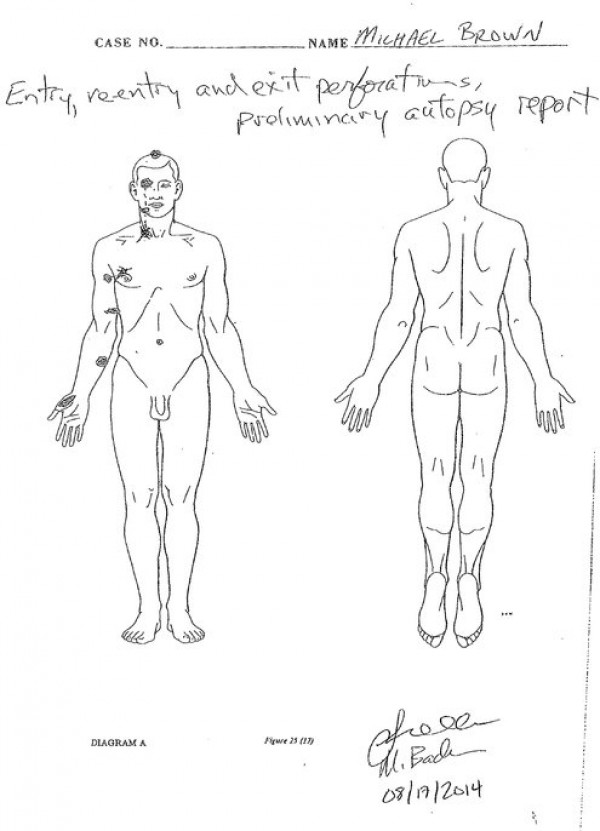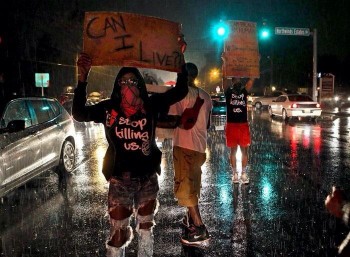
NEW YORK TIMES: Michael Brown, the unarmed black teenager who was killed by a police officer, sparking protests around the nation, was shot at least six times, including twice in the head, a preliminary private autopsy performed on Sunday found. One of the bullets entered the top of Mr. Brown’s skull, suggesting his head was bent forward when it struck him and caused a fatal injury, according to Dr. Michael M. Baden, the former chief medical examiner for the City of New York, who flew to Missouri on Sunday at the family’s request to conduct the separate autopsy. It was likely the last of bullets to hit him, he said. Attorney General Eric H. Holder Jr. said Sunday that the Justice Department would conduct its own autopsy, in addition to the one performed by local officials and this private one because, a department spokesman said, of “the extraordinary circumstances involved in this case and at the request of the Brown family.” The preliminary autopsy results are the first time that some of the critical information resulting in Mr. Brown’s death has been made public. Thousands of protesters demanding information and justice for what was widely viewed as a reckless shooting took to the streets here in rallies that ranged from peaceful to violent. Mr. Brown died Aug. 9 in a confrontation with a police officer here in this suburb of St. Louis. The police department has come under harsh criticism for refusing to clarify the circumstances of the shooting and for responding to protests with military-style operational gear. “People have been asking: How many times was he shot? This information could have been released on Day 1,” Dr. Baden said in an interview after performing the autopsy. “They don’t do that, even as feelings built up among the citizenry that there was a cover-up. We are hoping to alleviate that.” MORE
NEW YORK TIMES: Gov. Jay Nixon lifted the curfew in this embattled city on Monday, hours after deploying the Missouri National Guard as officials struggle to control unrest that has paralyzed the community since an unarmed black teenager was killed by a white police officer. The role of the National Guard will be limited, Mr. Nixon said in a statement. Troops will protect the police command center here, which the authorities said came under a coordinated attack on Sunday night. “With these additional resources in place, Mr. Nixon said, “the Missouri State Highway Patrol and local law enforcement will continue to respond appropriately to incidents of lawlessness and violence, and protect the civil rights of all peaceful citizens to make their voices heard.”
The authorities have been stymied in their efforts to quell the unrest. Mr. Nixon turned to the State Highway Patrol to oversee crowd control on Thursday after local officials were criticized for  heavy-handed tactics that included the use of tear gas and military-style vehicles. The state’s less confrontational approach seemed to calm the crowd for one night, but tensions between the police and protesters have since surpassed levels seen earlier. The Missouri State Highway Patrol said it faced coordinated attacks in Ferguson on Sunday, but a protester said the demonstrations were peaceful.
heavy-handed tactics that included the use of tear gas and military-style vehicles. The state’s less confrontational approach seemed to calm the crowd for one night, but tensions between the police and protesters have since surpassed levels seen earlier. The Missouri State Highway Patrol said it faced coordinated attacks in Ferguson on Sunday, but a protester said the demonstrations were peaceful.
On the street, law enforcement officials indicated Monday that they would take a different tack with protesters. People will not be allowed to congregate on the major thoroughfare that has been the center of the protests here. Officials said people could walk but not be stationary. At midmorning on Monday, about a dozen county and state police officers told a small group that it could not gather at the QuikTrip convenience store that had been burned last week during the unrest over the death of the teenager, Michael Brown. The 18-year-old was fatally shot by a police officer on Aug. 9.
People could walk up and down the street to protest, law enforcement officials told the group, which included the Rev. Jesse Jackson, but they could not stand in one place. “We’re not doing any more static protesting,” one state trooper said. “Here’s the biggest reason we’re asking people to move,” another trooper said. “So we can take care of it before it gets to that stage,” he said, referring to the violent unrest of previous nights. The move was met with angry protests from those assembled, who stayed but milled around a bit. “In its most generous way, it’s alienation,” Mr. Jackson said. “That will just compound the problem.” MORE
SALON: Oliver called out the Ferguson police department’s racism, our country’s irrational militarization of police forces, and the governor’s selectively applied logic when punishing the maligned community, concluding that “this is a top down problem. You took a community tired of being treated like criminals, and imprisoned them all in their own houses for a night,” Oliver said, criticizing Gov. Nixon. He continued, delivering a scathing indictment: “If even the governor can’t distinguish between the good and the bad elements of the community, and decides to punish everyone equally, then that should go both ways. I know the police love their ridiculous unnecessary military equipment, so here’s another patronizing test: let’s take it all away from them, and if they can make it through a whole month without killing a single unarmed black man, then — and only then– can they get their fucking toys back.” MORE
